Page 14 of 22
Re: CRINCH! The Crab of the Day!
Posted: Mon Oct 31, 2016 11:19 pm
by Nezumiiro

Photo credit:
Susan Middleton.CRINCH! #CrabOfTheDay for 10/31/2016: Just in time for Halloween, it’s Tanaoa distinctus, or The White Phantom Crab! This tropical Western and Central Pacific Ocean/Oceana native ‘purse’ crab hangs out at some pretty serious depths, (upwards to 800+ m!) where there’s plenty of settled detritus for it to forage! An interesting family Leucosiidae species, T. distinctus is taxonomically named after “Tanaoa” an ancient Polynesian god of primeval darkness, banished to the depths of the ocean, where total darkness still reigns.
http://www.marinespecies.org/aphia.php? ... &id=441345http://www.eol.org/pages/12172677/overview
Re: CRINCH! The Crab of the Day!
Posted: Tue Nov 01, 2016 7:54 pm
by Nezumiiro
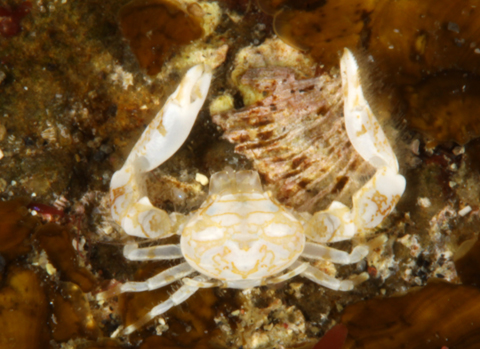
Photo credit:
Izuohshima Diving Center.CRINCH! #CrabOfTheDay for 11/01/2016: Heteropolyonyx biforma, or The Egao-gani (笑顔ガニ) which literally means “Smile Crab” in Japanese is a small Indo- and Western Central Pacific tropical crab. This family Porcellanidae species loves the coral beds found at or around the 100m depth zone. Named for the appearance of a smiling face on the back of its carapace, this Masayuki Osawa catalogued crab is the only member of its genus!
http://www.marinespecies.org/aphia.php? ... &id=410100http://www.sealifebase.org/summary/Hete ... forma.html
Re: CRINCH! The Crab of the Day!
Posted: Thu Nov 03, 2016 11:05 pm
by Nezumiiro

Photo credit:
Aycayia.
CRINCH! #CrabOfTheDay for 11/03/2016: Pagurus cuanensis, called The Common Hairy Hermit Crab is a widely distributed species, known for its bristly setae and AMAZING blue eyes. Found pretty much in ANY non-frozen area of the Atlantic, this crab seldom gets any bigger than 1.5 cm cross its carapace. The typical large right pincer is present in P. cuanensis, acting as a ‘hinged door’ to their shell when they hide inside. Additionally, this claw is strongly covered in hair, forming a sort of matted fur- most likely for filter feeding purposes.
www.marinespecies.org/aphia.php?p=taxdetails&id=107235http://www.eol.org/pages/347705/overview
Re: CRINCH! The Crab of the Day!
Posted: Fri Nov 04, 2016 9:26 pm
by Nezumiiro

Photo credit:
Ilan Ben Tov.CRINCH! #CrabOfTheDay for 11/04/2016: The Soft Coral Porcelain Crab, or Lissoporcellana Nakasonei is beautiful Asiatic family Porcellanidae crab notable for its intense, violet color. Found predominantly in Korea, Japan, and the South China Sea- this TINY crab has the long setae covered ‘scoops’ on it’s chelipeds, used for catching floating food bits. Like it’s cousins, L. Nakasonei is known as a “porcelain crab” from their propensity to drop appendages (fragile as porcelain!) which they grow back with great rapidity.
Photo credit: Stefano Scortegagna.
http://www.marinespecies.org/aphia.php? ... &id=410102http://www.eol.org/pages/10306565/overview
Re: CRINCH! The Crab of the Day!
Posted: Sat Nov 05, 2016 6:33 pm
by Nezumiiro
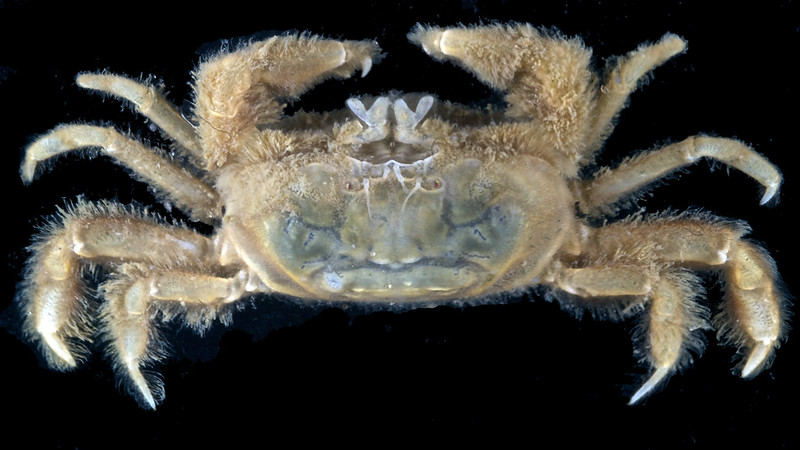
Photo credit:
The Crabby Taxonomist.CRINCH! #CrabOfTheDay for 11/05/2016: The Tube Pea Crab, or Pinnixa chaetopterana is a small species that (UNLIKE SOME PEA CRABS) lives rather harmlessly within the tube of the Parchment Worm, (polychaete) Chaetopterus variopedatus. This West Atlantic crab gets to live in the worm’s paper-like tube with it, and it return it cleans up detritus, planton, and potentially harmful smaller sea critters INCLUDING another pea crab, Polyonyx gibbesi. P. chaetopterana and P. gibbesi HATE each other and if placed together in a dish will fight and tear off each other's limbs. In the tube of C. variopedatus, generally a mated pair of crabs will take up a position posterior to the worm and if the worm turns round, they move so as to remain behind it.
The Tube Pea Crab is in-turn often host to the ribbon worm, Carcinemertes pinnotheridophila, is a parasite found in its branchial chambers. The worm's eggs can sometimes be seen attached to the hairs on the second abdominal appendage of the female crab alongside her own eggs.
…Just gross all around…
http://www.marinespecies.org/aphia.php? ... &id=158445http://www.eol.org/pages/340897/overview
Re: CRINCH! The Crab of the Day!
Posted: Sun Nov 06, 2016 11:50 am
by Nezumiiro
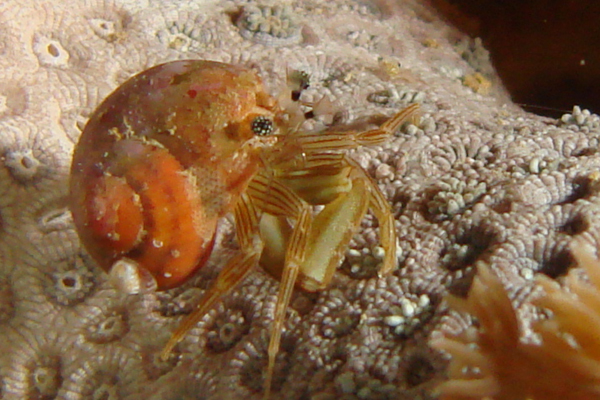
Photo credit:
J. Dumas.CRINCH! #CrabOfTheDay for 11/05/2016: Pagurixus rubrovittatusm or the appropriately named "Tiny Hermit Crab," is a diminutive family Paguridae species, found in some very distinct Southern Pacific locales: Madagascar and Papua New Guinea. While many Pagurixus crabs were first catalogued during the French expeditions of the 1930's, P. rubrovittatusm and some of its more recently differentiated cousins were found to be a separate, distinct Asiatic branch of the genus. Nailed down by Japanese carcinologist Tomoyuki Komai from the Chiba Natural History Museum and Institute in 2010, P. rubrovittatusm stands as the most-recent Genus Pagurixus distinction.
http://www.marinespecies.org/aphia.php? ... &id=503166http://skaphandrus.com/en/marine-animal ... rovittatus
Re: CRINCH! The Crab of the Day!
Posted: Mon Nov 07, 2016 10:56 pm
by Nezumiiro

Photo credit:
Tin-Yam Chan.CRINCH! #CrabOfTheDay for 11/07/2016: Pisidia serratifrons, or The Serrated Porcelain Crab (鋸額豆瓷蟹 in Taiwan) is a brilliantly violet marine family Porcellanidae species, found only in East Asia, Mozambique, and the Red Sea. Besides its bright carapace, this crab has distinct lobster-like antennae. Though typically less than a half-inch in size, P. serratifrons is still frightening with its gnarly, toothed claws. In Asia, Serrated Porcelain Crab occasionally finds its way into commercial oyster beds, where it can be a bit of a pest.
http://www.marinespecies.org/aphia.php? ... &id=217278http://crust.biota.biodiv.tw/pages/3958
Re: CRINCH! The Crab of the Day!
Posted: Thu Nov 10, 2016 1:58 am
by Nezumiiro

Photo credit:
Pere Abelló.CRINCH! #CrabOfTheDay for 11/08/2016: Bathynectes maravigna, or The Turkish Swimming Crab is a beautifully red and white spotted deep-sea paddler from the Aegean Sea, Mediterranean Sea, Alborán Sea, Catalano-Balearic Sea, Ionian Sea, Adriatic, and Thyrrenian Sea. WHEW! Swimming is some rather large schools, this bugger is PREDATORY! That’s right- B. maravigna will swim its prey down, and CRINCH-JACK it! Typically hanging out in waters deeper than 500 m, studies have determined that this family Polybiidae crab's distribution density is closely correlated with the overall ecological health of a given area.
http://www.marinespecies.org/aphia.php? ... &id=107377https://inpn.mnhn.fr/espece/cd_nom/350547?lg=en
Re: CRINCH! The Crab of the Day!
Posted: Thu Nov 10, 2016 2:00 am
by Nezumiiro
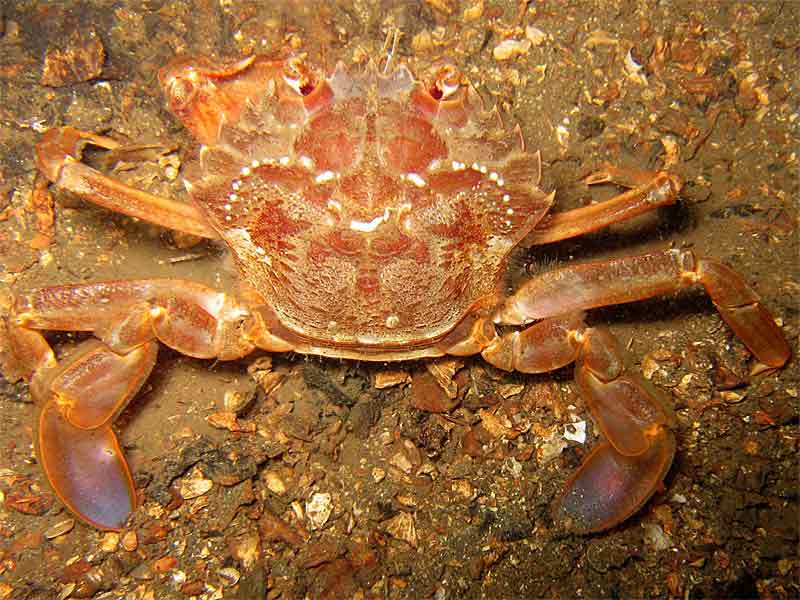
Photo credit:
Gordon Lang.CRINCH! #CrabOfTheDay for 11/09/2016: Liocarcinus holsatus, also known as The Irish Channel Crab or "Flying" Crab, is a swift family Portunidae species known for being both a competent swimmer, and a REALLY GOOD burrower! Thanks to its specialized paddle-shaped back legs, it moves readily through the water, (practically flying) while also able to dig in sand and gravel very quickly. Instead of a singular hard CRINCH, L. holsatus employs a rapid, scissoring action. Flaying Crabs hail from the North Atlantic, ESPECIALLY the colder Northern European/Russian waters .
http://www.marinespecies.org/aphia.php? ... &id=107388http://www.marlin.ac.uk/species/detail/1177
Re: CRINCH! The Crab of the Day!
Posted: Thu Nov 10, 2016 3:54 pm
by Nezumiiro
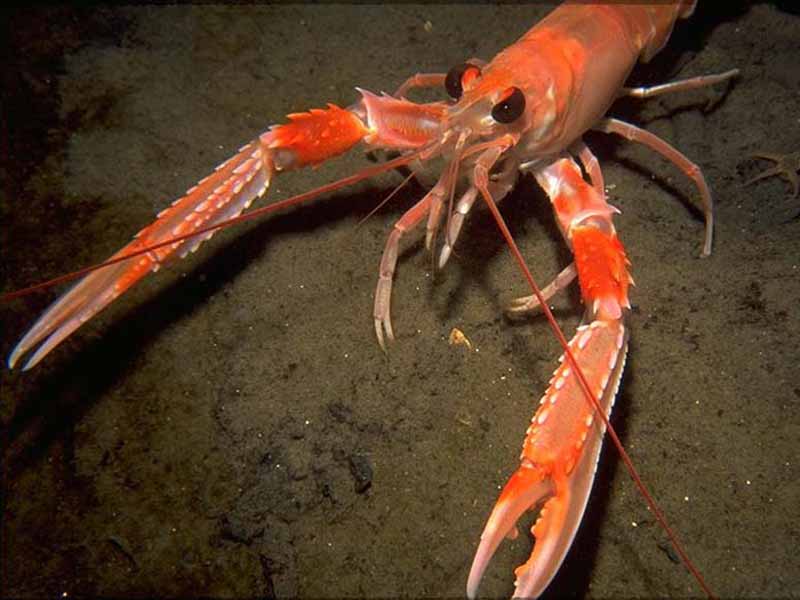
Photo credit:
Sue Scott.CRINCH! #CrabOfTheDay for 11/10/2016: Nephrops norvegicus, or The Norway Lobster is a widely distributed species of Nephropidae Langoustine, ranging from Iceland, the Faroes and Norway in the north of its range, to the Atlantic coast of Morocco in the south including the west and central region of the Mediterranean. This slim, orange-pink lobster is known as "the most important commercial crustacean in Europe," being raised in upwards of 75 commercial fisheries in over 20 countries. The only extant species in the genus Nephrops, these nocturnal snappers emerge from their burrows at night to feed on worms and fish.
Fun Fact: The typical life span of N. norvegicus is 5–10 years, reaching 15 years in exceptional cases.
http://www.marinespecies.org/aphia.php? ... &id=107254http://www.marlin.ac.uk/species/detail/1672
Re: CRINCH! The Crab of the Day!
Posted: Sat Nov 12, 2016 12:19 pm
by Nezumiiro

Photo credit:
NOAA Okeanos Explorer Program, Gulf of Mexico: 2012 Expedition.
CRINCH! #CrabOfTheDay for 11/12/2016: Chaceon quinquedens, or The Red Deeepsea Crab is a stunning family Geryonidae species, routinely found in the North and Mid-Western Atlantic fropm Nova Scotia, to The Gulf of Mexico. Found along the continental shelf edge and slope, C. quinquedens hangs out in unconsolidated and consolidated silt-clay sediments, making its habitat and diet EXTREMELY easy to replicate for commercial fishery purposes. Red Deeepsea Crabs are the mainstay for a commercial fishery off the coast of New England since the 1970’s and have had annual harvests from upwards of 400 metric tons!
FUN FACT: The larvae of this species may remain planktonic for up to 4 months before settlement depending on water temperature.
http://www.marinespecies.org/aphia.php? ... &id=158407https://www.itis.gov/servlet/SingleRpt/ ... 20992#nullhttp://icesjms.oxfordjournals.org/content/65/6/862.full
Re: CRINCH! The Crab of the Day!
Posted: Sun Nov 13, 2016 9:27 pm
by Nezumiiro
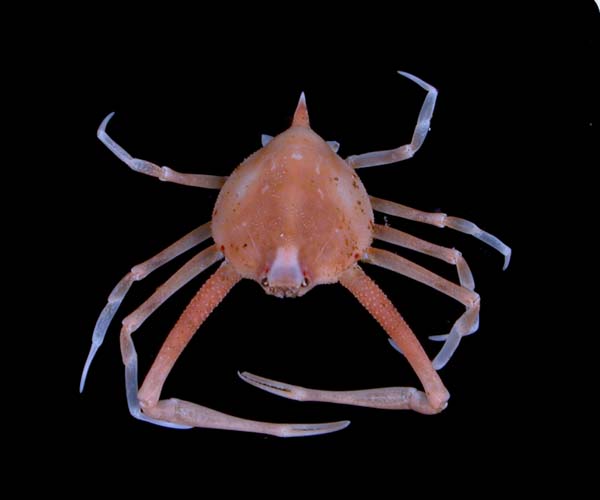
Photo credit:
Southeastern Regional Taxonomic Center. (SERTC)CRINCH! #CrabOfTheDay for 11/13/2016: Acanthilia intermedia, or The Granulose Purse Crab is an Atlantic Leucosiidae species found in the Gulf of Mexico and infrequently in the Eastern coasts of the Americas; from North Carolina to Brazil. This soft-bottom dweller can inhabit depths from as shallow as 10 meters to off-shelf sinks as deep as 329 meters. Recognizable by its grainy, round carapace- A. intermedia populations amass during breeding season, especially visible in the NC, SC, and Georgian Sea Islands. (Tybee!)
http://www.marinespecies.org/aphia.php? ... &id=421926http://eol.org/pages/1024050/overview
Re: CRINCH! The Crab of the Day!
Posted: Tue Nov 15, 2016 1:31 am
by Nezumiiro
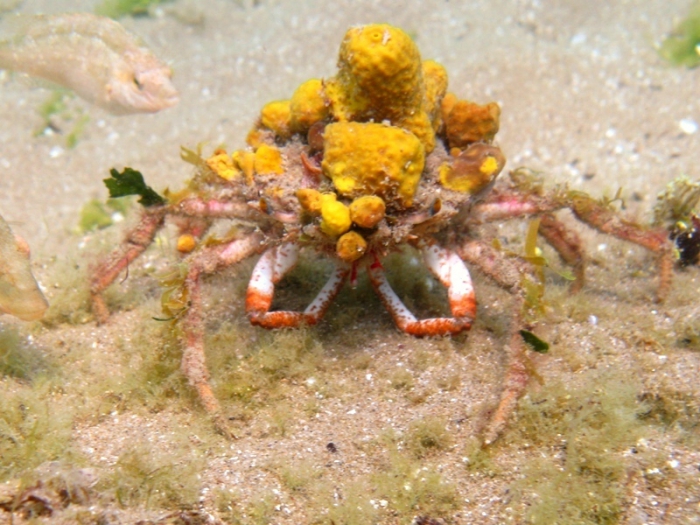
Photo credit:
Roberto Pillon.CRINCH! #CrabOfTheDay for 11/14/2016: The Disguised Spider Crab, or Maja crispate is a decorator family Majidae species, found in the Mediterranean and North Atlantic Ocean. Sometimes referred to as the “Small” Spider Crab or “Lesser” Spider Crab, this Risso catalogued crustacean has a more tapered red-brown body than other close relatives, and seems to typically have a more naturally thought out camouflage decorating scheme than the average decorator. Relying as much on texture and variety than the simple “little bit of everything,” M. crispate seems to have it figured out!
http://www.marinespecies.org/aphia.php? ... &id=107348http://www.eol.org/pages/342866/overview
Re: CRINCH! The Crab of the Day!
Posted: Tue Nov 15, 2016 10:14 pm
by Nezumiiro

Photo credit:
Ng et al.CRINCH! #CrabOfTheDay for 11/15/2016: Homola mieensis, or The Triple Face Crab (三重人面蟹 in Chinese) is a spiky family Homolidae species hailing from East Asia, the NCEEZ, and parts of the Western Pacific. Possessing slender, long chelipeds and a distinct spine pattern, this bright orange carnivorous crustacean lives at depths up to 1000 meters!
http://crust.taibif.tw/pages/5730http://species-identification.org/speci ... pan&id=643
Re: CRINCH! The Crab of the Day!
Posted: Wed Nov 16, 2016 11:14 pm
by Nezumiiro
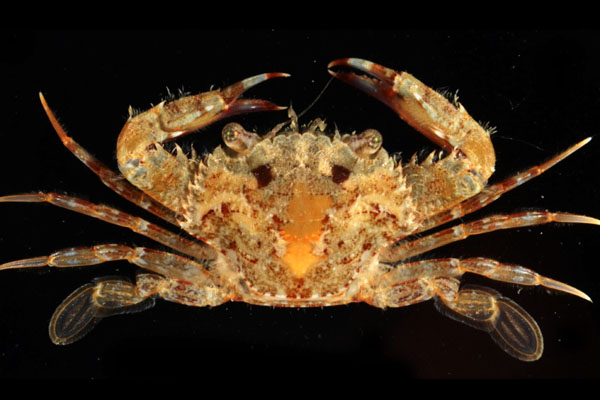
Photo credit:
Y. Buske.CRINCH! #CrabOfTheDay for 11/16/2016: Cronius tumidulus, or The Crevice Sculling Crab is- as its name suggest, a crevice-dwelling, family Portunidae swimming crab. Found in the Gulf of Mexico West Atlantic Islands, and Brazil, C. tumidulus lives in the shallow waters shore-adjacent. Recognizable by the blue band on their chelipeds, Crevice Scullers stand as one of two living members of the genus Cronius. (The other species is C. Ruber!)
FUN FACT: "Cronius" was a celebrated 2nd century Greek Neopythagorean philosopher.
http://www.marinespecies.org/aphia.php? ... &id=422040https://www.itis.gov/servlet/SingleRpt/ ... 98709#null
Re: CRINCH! The Crab of the Day!
Posted: Thu Nov 17, 2016 8:32 pm
by Nezumiiro

Photo credit:
Marinas y Costeras, Museo de Historia Natural Marina de Colombia.CRINCH! #CrabOfTheDay for 11/17/2016: Ethusina abyssicola, or The Abyssal Sumo Crab is a gangly, leggy family Ethusidae species endemic to Warmer South Atlantic Waters, namely Massachusetts, North Carolina, the Gulf of Mexico, Brazil, Argentina and small locales in the Mediterranean Sea and Spain. These small deep-sea crabs are adapted to carrying objects on their backs for camouflage and/or defense. E. abyssicola happens to be the only species of the genus occurring in the West Atlantic. Living at depths of up to 3000 m, (The greatest depth record for any brachyuran crab in the southwestern Atlantic!) Abyssal Sumos from the DEEPEST canyons and sinks have their outer orbital spines pointed forward and not outwards such as is the case with shallower dwellers. The significance of this spine difference is presently unknown.
http://www.marinespecies.org/aphia.php? ... &id=209493http://caliban.mpipz.mpg.de/doflein/tie ... _3146.html
Re: CRINCH! The Crab of the Day!
Posted: Sun Nov 20, 2016 4:58 pm
by Nezumiiro

Photo credit:
Aaron Baldwin.
CRINCH! #CrabOfTheDay for 11/20/2016: Description: Pagurus dalli, or The Whiteknee Hermit Crab is an AMAZING species of subtidal hermit, found in a variety of locales; from the Bering Sea to Oregon. This weirdo lives symbiotically with the sponges Suberites latus and Suberites ficus, which dissolves and overgrows its shell. Usually these sponges live in conjunction with the hydroid Hydractinia milleri which also encrusts shells which have hermit crabs living in them, and eventually to overgrow the shell as the crab grows. The three types of animals living together have much higher rates of success than each do individually! The presence of Hydractinia on a hermit crab seems to at least partially deter predation by octopi that usually readily eat hermit crabs yet will think twice about attacking a hermit crab with hydroids on its shell!
http://www.marinespecies.org/aphia.php? ... &id=366676http://eol.org/pages/313422/overview
Re: CRINCH! The Crab of the Day!
Posted: Mon Nov 21, 2016 10:21 pm
by Nezumiiro

Photo credit:
B.J. Stacey.CRINCH! #CrabOfTheDay for 11/21/2016: Cycloxanthops novemdentatus, or The Ninetooth Pebble Crab is a diminutive family Xanthidae pebble crab found in the waving California-to-South American kelp beds of the Eastern Pacific. Typically dull-reddish brown to purple in color, this tiny crustacean succeeds in the world of detritus hunters due to its relatively diverse and equally tiny diet requirements. C. novemdentatus fills an important ecological role as an indicator species of the general health of its chosen kelp bed.
Fun Fact: The Latin ‘Novemdentatus’ means "Nine-tooth."
http://www.marinespecies.org/aphia.php? ... &id=444237http://www.inaturalist.org/taxa/469740- ... emdentatus
Re: CRINCH! The Crab of the Day!
Posted: Tue Nov 22, 2016 8:19 pm
by Nezumiiro

Photo credit:
M.J. Rathbun.CRINCH! #CrabOfTheDay for 11/22/2016: Deilocerus planus, or The Chip Crab is a small family Cyclodorippidae species found off the coast of Central California and southward through the Baja peninsula. "Chippies" have a sub-circular carapace (meaning it's a little broader than it is long) ending in two triangular points. Additionally these little guys have a line of three spines beginning right behind their eye. Found at depths ranging from 11 m to 125 m, this shallow dweller lives in the gravel and shell beds where it can be seen carrying pieces of shell, pebbles, sticks, or clumps of algae over their carapaces by means of their specialized hind legs.
The Genus Deilocerus only has eight members to date.
http://www.marinespecies.org/aphia.php? ... &id=439986http://www.eol.org/pages/1037980/overview
Re: CRINCH! The Crab of the Day!
Posted: Wed Nov 23, 2016 11:22 pm
by Nezumiiro
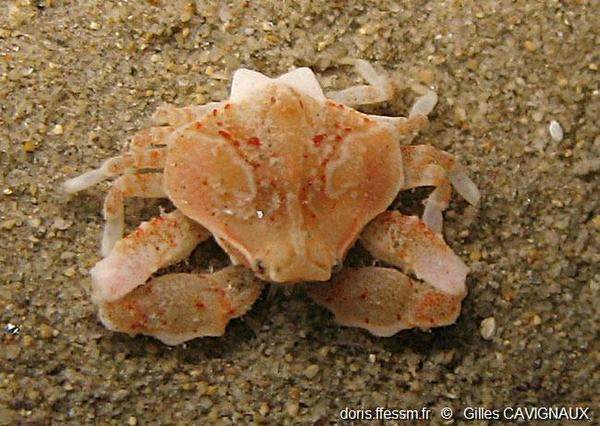
Photo credit:
Gilles Cavignaux.CRINCH! #CrabOfTheDay for 11/23/2016: Ebalia deshayesi, or The Roman Nut Crab is a great family Leucosiidae species, frequently sighted in the Aegean, Alboran, Balearic, and Mediterranean Seas and parts of the European North Atlantic. These tiny granular-carapaces’d crabs live at depths from 5m – 50m, though they’ll occasionally stray into depths up to 200m! On the dorsal (posterior) side of E. deshayesi’s carapace there are noticeable bumps- distinguishing it from all its other genus Ebalia relatives.
http://www.marinespecies.org/aphia.php? ... &id=107295http://www.gbif.org/species/4382650
Re: CRINCH! The Crab of the Day!
Posted: Sun Dec 04, 2016 1:14 pm
by Nezumiiro

Photo credit:
Thierry Rakotoarivelo.CRINCH! #CrabOfTheDay for 11/24/2016: The Sponge Decorator Crab (Hyastenus elatus) is a species family Epialtidae Spider Crab which habitually covers itself in aposematic sponges, to serve as camouflage. The carapace of this Majid is covered with spines, knobs and hooked hairs. These structures are very important as they allow the crab anchor points for algae, sponges and hydroids! H. elatus is distributed around tropical Australia from Fremantle in the West to Shellharbour in the East. Other smaller populations may be found in other parts of the West Pacific including Indonesia and Papua New Guinea.
http://www.marinespecies.org/aphia.php? ... &id=441563http://eol.org/pages/4315903/overview
Re: CRINCH! The Crab of the Day!
Posted: Sun Dec 04, 2016 1:18 pm
by Nezumiiro

Photo credit:
Rusty Eulberg.CRINCH! The BONUS #CrabOfTheDay for 11/24/2016: The Cthurkey! An Octopus-Stuffed Turkey with Crab Legs! In November, Rusty Eulberg of Lubbock posted a photo of his Christmas dinner: an unsettling combination of turkey, bacon, octopus and crab legs inspired by turn-of-the-century writer H.P. Lovecraft’s literary beast-god from the deep, Cthulhu.
"A horrifying beast rises from the South Pacific. Its mouth is a dripping, writhing mass of tentacles. It has a dragon’s body, a bat’s wings.
And it’s heading for the dinner table."
http://www.foodiggity.com/behold-the-ct ... crab-legs/
Re: CRINCH! The Crab of the Day!
Posted: Sun Dec 04, 2016 1:23 pm
by Nezumiiro

Photo credit:
The #CrabOfTheDay Family.CRINCH! #CrabOfTheDay for 11/25/2016: Cutie Neocrinchus, otherwise called the North American Rivers Cicero Crab is pretty dang cute. Made of 3/4 poop and 1/4 intense glances, this species is REALLY AMAZING if you ask me.
P.S. This crabby little thing is my baby! For those that have followed #CrabOfTheDay since 2011, thanks a ton for scuttling the long reef up to this point! I’m sure y’all have zoea of your own, give ‘em a loving CRINCH from us!
Re: CRINCH! The Crab of the Day!
Posted: Sun Dec 04, 2016 1:27 pm
by Nezumiiro
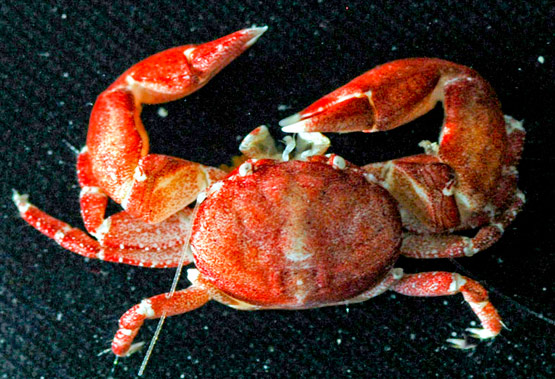
Photo credit:
Tin-Yam Chan.CRINCH! #CrabOfTheDay for 11/27/2016: Polyonyx obesulus, or The Red False Crab is a bright red family Porcellanidae 'Porcelain Crab' from the Indo-West Pacific and New Caledonian Exclusive Economic Zone. Typically living in the hollows of tubular red sponges, these small crabs differ from other related red porcelains in that their eggs are ridiculously dark blue. P. obesulus prefers the shallows, on or about 50m deep.
http://www.marinespecies.org/aphia.php? ... &id=410142http://www.eol.org/pages/4258724/overview
Re: CRINCH! The Crab of the Day!
Posted: Sun Dec 04, 2016 1:29 pm
by Nezumiiro

Photo credit:
Jim Anderson.CRINCH! #CrabOfTheDay for 11/28/2016: Chirostylus ortmanni, or Ortmann's Spider Crab (in Japanese: オルトマンワラエビ) is a bizarre looking Family Chirostylidae beastie typically found living on the Gorgonians swaying in shallow Southeast Asian and Taiwanese reefwaters, these anomuran chirostylid crabs have finger print-like arrangements of spines, making them a very morphologically differentated species. Techniclly speaking, C. ortmanni and its close cousins are squat lobsters!
http://www.marinespecies.org/aphia.php? ... &id=391988http://www.eol.org/pages/8635356/overview
























